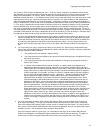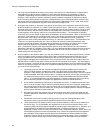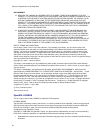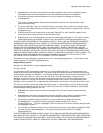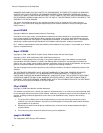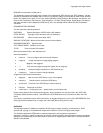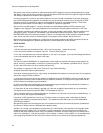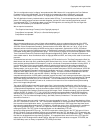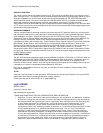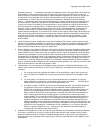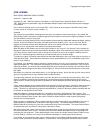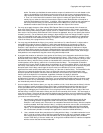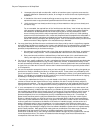Copyrights and Legal Notices
55
The Unix configuration script "configure" was produced with GNU Autoconf. It is copyright by the Free Software
Foundation but is freely distributable. The same holds for its supporting scripts (config.guess, config.sub,
ltmain.sh). Another support script, install-sh, is copyright by X Consortium but is also freely distributable.
The IJG distribution formerly included code to read and write GIF files. To avoid entanglement with the Unisys LZW
patent, GIF reading support has been removed altogether, and the GIF writer has been simplified to produce
"uncompressed GIFs". This technique does not use the LZW algorithm; the resulting GIF files are larger than
usual, but are readable by all standard GIF decoders.
We are required to state that
"The Graphics Interchange Format(c) is the Copyright property of
CompuServe Incorporated. GIF(sm) is a Service Mark property of
CompuServe Incorporated."
REFERENCES
We recommend reading one or more of these references before trying to understand the innards of the JPEG
software. The best short technical introduction to the JPEG compression algorithm is Wallace, Gregory K. "The
JPEG Still Picture Compression Standard", Communications of the ACM, April 1991 (vol. 34 no. 4), pp. 30-44.
(Adjacent articles in that issue discuss MPEG motion picture compression, applications of JPEG, and related
topics.) If you don't have the CACM issue handy, a PostScript file containing a revised version of Wallace's article
is available at http://www.ijg.org/files/wallace.ps.gz. The file (actually a preprint for an article that appeared in IEEE
Trans. Consumer Electronics) omits the sample images that appeared in CACM, but it includes corrections and
some added material. Note: the Wallace article is copyright ACM and IEEE, and it may not be used for commercial
purposes.
A somewhat less technical, more leisurely introduction to JPEG can be found in "The Data Compression Book" by
Mark Nelson and Jean-loup Gailly, published by M&T Books (New York), 2nd ed. 1996, ISBN 1-55851-434-1. This
book provides good explanations and example C code for a multitude of compression methods including JPEG. It
is an excellent source if you are comfortable reading C code but don't know much about data compression in
general. The book's JPEG sample code is far from industrial-strength, but when you are ready to look at a full
implementation, you've got one here... The best currently available description of JPEG is the textbook "JPEG Still
Image Data Compression Standard" by William B. Pennebaker and Joan L. Mitchell, published by Van Nostrand
Reinhold, 1993, ISBN 0-442-01272-1. Price US$59.95, 638 pp. The book includes the complete text of the ISO
JPEG standards (DIS 10918-1 and draft DIS 10918-2). Although this is by far the most detailed and
comprehensive exposition of JPEG publicly available, we point out that it is still missing an explanation of the most
essential properties and algorithms of the underlying DCT technology. If you think that you know about DCT-based
JPEG after reading this book, then you are in delusion. The real fundamentals and corresponding potential of
DCT-based JPEG are not publicly known so far, and that is the reason for all the mistaken developments taking
place in the image coding domain.
The original JPEG standard is divided into two parts, Part 1 being the actual specification, while Part 2 covers
compliance testing methods. Part 1 is titled "Digital Compression and Coding of Continuous-tone Still Images, Part
1: Requirements and guidelines" and has document numbers ISO/IEC IS 10918-1, ITU-T T.81. Part 2 is titled
"Digital Compression and Coding of Continuous-tone Still Images, Part 2: Compliance testing" and has document
numbers ISO/IEC IS 10918-2, ITU-T T.83. IJG JPEG 8 introduces an implementation of the JPEG SmartScale
extension which is specified in a contributed document at ITU and ISO with title "ITU-T JPEG-Plus Proposal for
xtending ITU-T T.81 for Advanced Image Coding", April 2006, Geneva, Switzerland. The latest version of the
document is Revision 3.
The JPEG standard does not specify all details of an interchangeable file format. For the omitted details we follow
the "JFIF" conventions, revision 1.02. JFIF 1.02 has been adopted as an Ecma International Technical Report and
thus received a formal publication status. It is available as a free download in PDF format from http://www.ecma-
international.org/publications/techreports/E-TR-098.htm. A PostScript version of the JFIF document is available at
http://www.ijg.org/files/jfif.ps.gz. There is also a plain text version at http://www.ijg.org/files/jfif.txt.gz, but it is
missing the figures. The TIFF 6.0 file format specification can be obtained by FTP from
ftp://ftp.sgi.com/graphics/tiff/TIFF6.ps.gz. The JPEG incorporation scheme found in the TIFF 6.0 spec of 3-June-
92 has a number of serious problems. IJG does not ecommend use of the TIFF 6.0 design (TIFF Compression tag
6). Instead, we recommend the JPEG design proposed by TIFF Technical Note #2 (Compression tag 7). Copies of
this Note can be obtained from http://www.ijg.org/files/. It is expected that the next revision of the TIFF spec will
replace the 6.0 JPEG design with the Note's design. Although IJG's own code does not support TIFF/JPEG, the
free libtiff library uses our library to implement TIFF/JPEG per the Note.



